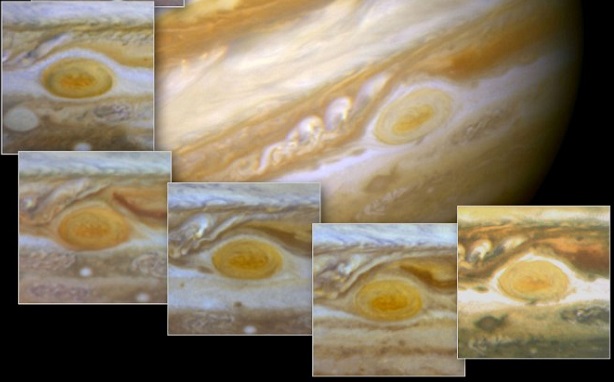Nasa probe successfully peers into Jupiter’s Great Red Spot

This 1999 NASA Hubble Space Telescope file image shows the Great Red Spot in Jupiter’s atmosphere. The spot is a vast storm, spinning like a cyclone. Unlike a low-pressure hurricane in the Caribbean Sea, however, the Red Spot rotates in a counterclockwise direction in the southern hemisphere, showing that it is a high-pressure system. Winds inside this Jovian storm reach speeds of about 270 mph. The Red Spot is the largest known storm in the Solar System. With a diameter of 15,400 miles, it is almost twice the size of the entire Earth and one-sixth the diameter of Jupiter itself. The Red Spot does change its shape, size, and color, sometimes dramatically. Such changes are demonstrated in high-resolution images of Jupiter obtained by NASA’s Hubble Space Telescope. The mosaic presents a series of pictures of the Red Spot obtained by Hubble between 1992 and 1999. AFP
MIAMI, United States — A NASA spacecraft, Juno, has successfully peered into the giant storm raging on Jupiter, known as the Great Red Spot, and its first pictures should be out in days, the US space agency said Tuesday.
“My latest Jupiter flyby is complete!” said a post on the @NASAJuno Twitter account.
“All science instruments and JunoCam were operating to collect data.”
The unmanned spacecraft came closer than any before it to the iconic feature on the solar system’s largest planet, the gas giant Jupiter.
Experts say the Great Red Spot is a massive storm — some 10,000 miles (16,000 kilometers) wide — that has been churning for centuries, but little is known about the forces driving it.
It has been monitored since 1830 and has possibly existed for more than 350 years.
The storm is believed to have been shrinking in recent years.
“For generations, people from all over the world and all walks of life have marveled over the Great Red Spot,” said Scott Bolton, principal investigator on the Juno project.
“Now we are finally going to see what this storm looks like up close and personal.”
The flyover took place July 10 at 9:55 pm (July 11 at 0155 GMT), as the spacecraft passed about 5,600 miles (9,000 kilometers) above the spot’s coiling crimson clouds.
“Raw images will be posted in (the) coming days,” the space agency said.
Juno launched on August 5, 2011, from Cape Canaveral, Florida, and has been orbiting Jupiter for just over one year. CBB